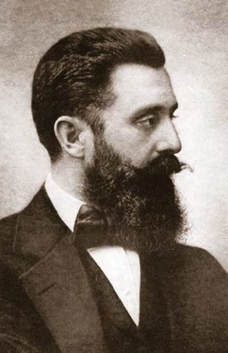 The publication of Theodore Herzl’s Der Judenstaat in 1896 marked the birth of the modern Zionist movement. (Wikimedia Commons)
The publication of Theodore Herzl’s Der Judenstaat in 1896 marked the birth of the modern Zionist movement. (Wikimedia Commons) By contrast, Central European Jews—many of whom had arrived earlier in the nineteenth century, embraced Reform Judaism, and acculturated to a significant degree—largely opposed Zionism. Reform Jews, including those in Alabama, supported the position taken in 1885 by the Central Conference of American Rabbis: “We consider ourselves no longer a nation, but a religious community, and therefore expect neither a return to Palestine, nor a sacrificial worship under the sons of Aaron, nor the restoration of any of the laws concerning the Jewish state.” They viewed themselves as Americans and adhered to the Reform position that saw acculturation into the larger American culture as the key to success. Alabama’s Reform Jews worried that any support for the Zionist cause would single them out as incompatible with the accepted cultural norms and southern traditions. Their inability to blend into a region of rigid conformity, they feared, would only serve to make them more conspicuous. As Rabbi Eugene Blachschleger of Montgomery’s Temple Beth Or taught his congregants, “I’m a Caucasian by race, I’m an American by nationality, and my faith is Judaism.”
This clash over Zionism added to already stark differences in religion, culture, and class between Eastern European and Central European Jews. As Birmingham Zionist leader Abe Berkowitz noted, prior to 1933 Alabama’s Reform Jews “had nothing whatever to do with Zionism.... It is fair to say that...they generally viewed Zionism as synonymous with Russian or Polish Jews.” Hitler’s assumption of power, how- ever, expanded the movement to include Reform Jews. As Nazi anti-Semitic policies and pogroms increased, Eastern European and Central European Jews worked hand-in- hand in Birmingham, Mobile, and Montgomery to alleviate Jewish suffering abroad. As the mass murder of European Jews became known by late 1942, many Reform Jews who had emphatically rejected the Zionist cause began seeing a Jewish state as a viable and even necessary option for Jewish survival.
Russian immigrants Frank and Ike Abelson founded one of the first Zionist organizations in Alabama.
Two of those young Reform rabbis seared by the fires of the Holocaust, Rabbi Milton Grafman of Birmingham’s Temple Emanu-El and Rabbi Bertram Wallace Korn of Mobile’s Congregation Sha’arai Shomayim, did much to champion Zionism within their cities and congregations. Grafman, for instance, joined an already active Zionist organization in Birmingham and began to attract congregants to a movement that had been largely bereft of Reform members. Moreover, because Reform rabbis generally had a greater public profile than either Conservative or Orthodox rabbis and were viewed as “ambassadors to the Gentiles,” Grafman and Korn helped to popularize the movement beyond the Jewish community. By mid-1943, lobbying efforts by Zionists resulted in the Alabama legislature becoming the first in the United States to endorse the creation of a Jewish state. Rep. Sid Smyer and Sen. James Simpson, both of Birmingham, sponsored a joint resolution in May 1943 stating that the “policy of the Axis powers to exterminate the Jews of Europe through mass murder cries out for action by the United Nations representing the civilized world” and calling for the “establishment of a Jewish homeland in Palestine.”
Many Reform Jews who had been ambivalent or antagonistic toward Zionism in the pre-war years reassessed their position, while others simply accepted Zionism as a fait accompli after 1948.
The close relationship between American Jews and Israel did not develop overnight. After Israel faced existential threats during the Six-Day War in 1967 and the Yom Kippur War in 1973, both of which evoked memories of the Holocaust, more American Jews moved closer to the Jewish state. Recent national opinion polls, moreover, suggest that continuing threats to Israel, such as those from Iran, have prompted American Jews to support the Jewish state in even greater numbers. The bond between American Jews and the embattled Jewish state, although not without controversy, remains strong in Alabama and throughout the country, forged from the persistence of Zionism and the traumatic experiences of the Holocaust.
This feature was previously published in Issue 106, Fall 2012.
Author
Dan J. Puckett, associate professor of history at Troy University, is the author of the forthcoming In the Shadow of Hitler: Alabama’s Jews and the Holocaust (University of Alabama Press). Joshua D. Rothman, standing editor of the “Southern Religion” department of Alabama Heritage, is associate professor of history at the University of Alabama and director of the university’s Frances S. Summersell Center for the Study of the South, which sponsors this department.
 RSS Feed
RSS Feed